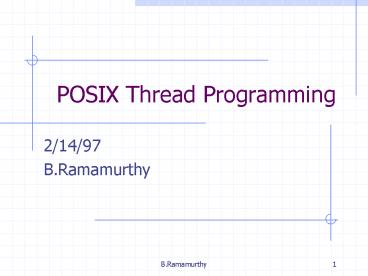POSIX Thread Programming - PowerPoint PPT Presentation
Title:
POSIX Thread Programming
Description:
To study thread control primitives for creation, termination, join, ... See the multi_thr.c example from Pthreads book by Lewis and Berg. ... – PowerPoint PPT presentation
Number of Views:99
Avg rating:3.0/5.0
Title: POSIX Thread Programming
1
POSIX Thread Programming
- 2/14/97
- B.Ramamurthy
2
Topics to be Covered
- Objective
- POSIX threads
- What are Threads?
- Creating threads
- Using threads
- Summary
3
Objective
- To study POSIX standard for threads called
Pthreads. - To study thread control primitives for creation,
termination, join, synchronization, concurrency,
and scheduling. - To learn to design multi-threaded applications.
4
Creating threads
- Always include pthread library
- include ltpthread.hgt
- int pthread_create (pthread_t threadp, const
pthread_attr_t attr, void ( start
routine)(void ), void arg) - This creates a new thread of control that calls
the function start_routine. - It return a zero if the creation is successful,
and thread id in threadp (first parameter). - attr is to modify the attributes of the new
thread. If it is NULL, default attributes are
used. - The arg is passing arguments to the thread
function.
5
Using threads
- 1. Declare a variable of type pthread_t
- 2. Define a function to be executed by the
thread. - 3. Create the thread using pthread_create
- Make sure creation is successful by checking the
return value. - 4. Pass any arguments need through arg (packing
and unpacking arg list necessary.) - 6. Compile cc o xyz xyz.c options such as
lthread lpthread
6
Threads local data
- Variables declared within a thread (function) are
called local data. - Local (static) data associated with a thread are
allocated on the stack. So these may be
deallocated when a thread returns. - So dont plan on using locally declared variables
for returning arguments. Plan to pass the
arguments thru argument list passed from the
caller or initiator of the thread.
7
Thread termination (destruction)
- Implicit Simply returning from the function
executed by the thread terminates the thread. In
this case threads completion status is set to
the return value. - Explicit Use thread_exit.
- Prototype void thread_exit(void status)
- The single pointer value in status is available
to the threads waiting for this thread.
8
Waiting for thread exit
- int pthread_join (pthread_t tid, void statusp)
- A call to this function makes a thread wait for
another thread whose thread_id is specified by
tid in the above prototype. - When the thread specified by tid exits its
completion status is stored(returned) in statusp.
9
Example
- See the multi_thr.c example from Pthreads book by
Lewis and Berg. - This is available in /projects/bina/Pthreads
- We will walk through the execution of this
program to understand basic thread control. - Anything specified in Uppercase are
functions/macro made by the authors. - Example PTHREAD_CREATE
10
PTHREAD_CREATE
- Is a robust version of the simple pthread_create
of the posix library. - int err
- if (err pthread_create(new_thread_ID,
- attr, start_func,
arg) - printf(s\n, strerror(err))
- abort()
11
Other pthread functions
- pthread_self to get the handle for itself.
- Synchronization
- pthread_mutex_t
- pthread_mutex_lock (lock)
- pthread_mutex_unlock(lock)
- sema_t, sema_init, sema_wait, sema_post,
sema_destroy
12
Summary
- We will look at the basic thread operation in
this lecture. - We will look into the details of critical
section, need for synchronization,
synchronization models in the next lecture.































